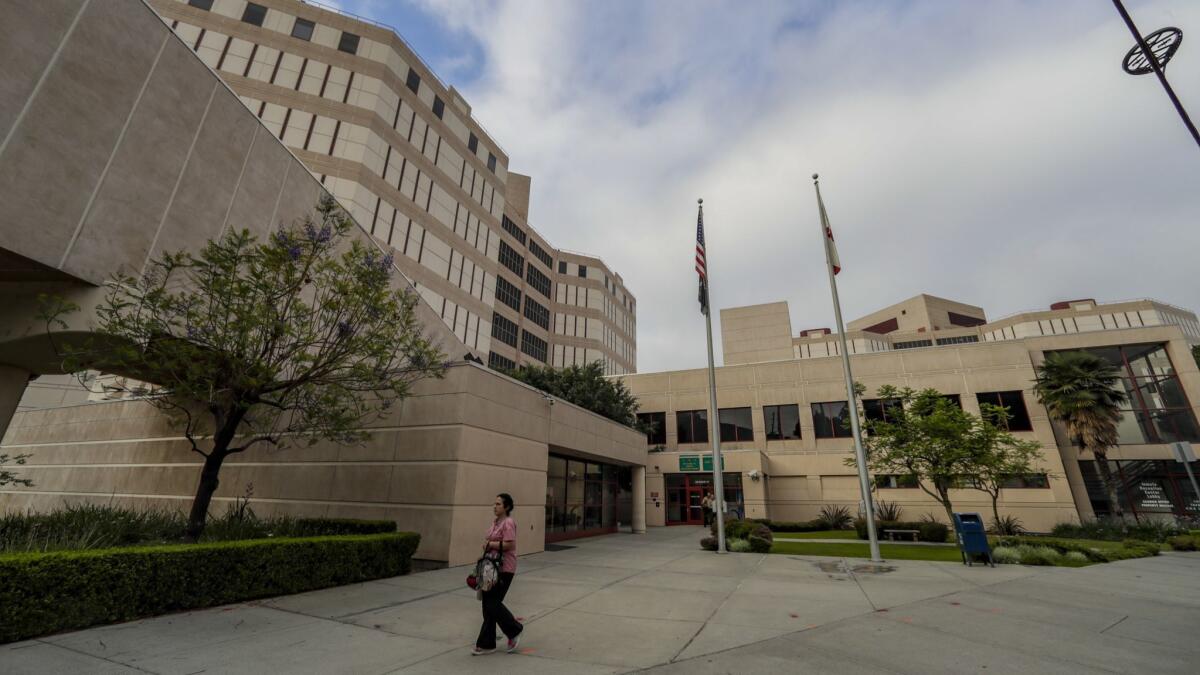Editorial: L.A. County needs more mental health treatment. It also needs a plan to provide for it

- Share via
The recent evolution in the Board of Supervisors’ thinking about how to replace the dangerous and decrepit Men’s Central Jail has been breathtaking. After years of insisting on building a multibillion-dollar treatment-oriented replacement jail, the supervisors in a matter of weeks have soured on the idea and are considering instead an actual psychiatric hospital, operated by mental health professionals.
The change in attitude is welcome. Throwing mentally ill people routinely in jail instead of treatment facilities is foolish and morally suspect, even if some of those people have been accused of crimes.
The supervisors are moving so quickly, though, that they are in danger of getting ahead of themselves. Over recent weeks they have asked for several studies on incarceration-related topics, including the county’s needs for mental health beds, for gender-responsive treatment and incarceration, and for diversion from the criminal justice system. They are the right questions. Now the supervisors ought to get the answers before making any final decisions on how to spend between $2 billion and $4 billion in bond funding.
The supervisors are right to rethink jail spending and focus on mental health care. But building a huge county mental hospital may not be the right step.
They’re scheduled to vote Tuesday on whether to go ahead with the original plan for a jail known as the Consolidated Correctional Treatment Facility, or alternatively to sign a deal with the same contractor for a different facility with a different name to serve a different purpose — mental health care — presumably on the same site, in the jail complex on the northern edge of downtown Los Angeles.
But it is not a binary choice. Not all mental illnesses are the same. State mental hospitals fell into disrepute a half-century ago precisely because they were a one-size-fits-all solution for treating mental illness, and many become warehouses for patients suffering from all variety and degree of psychiatric and emotional ailments.
In signing his very last bill, President Kennedy in 1963 spoke of the promise of community-based treatment for the mentally ill. He used words reminiscent of his call to put a man on the moon.
“Under this legislation,” he said, “custodial mental institutions will be replaced by therapeutic centers. It should be possible, in a decade or two, to reduce the number of patients in mental institutions by 50% or more. The new law provides the tools with which we can accomplish this objective.”
Mental hospitals closed, but few of the promised community clinics and centers were built. Over the following decades, federal laws and state bonds raised billions for jails, and that’s where many untreated mentally ill people have ended up. How different would things be today if the $16 billion authorized for prison construction in the 1994 crime bill, for example, had been used to build mental health facilities instead?
The supervisors are right to rethink jail spending and focus on mental health care. But building a huge county mental hospital may not be the right step. Supervisors need to better understand the different needs of the patient population.
Some may well need a mental hospital of the type the state still operates. Some no doubt will have to live in such places long term. Many others will need treatment for acute episodes and then move to “step-down” beds that transition them to either permanent supportive housing or their own homes and normal lives with or without continuing treatment. Many need outpatient clinical care. And some, mental illness notwithstanding, belong in jail or prison. The supervisors need to know how many people can be expected to fall into each category.
Enter the Fray: First takes on the news of the minute »
Some things the supervisors already know. For example, they know they have to demolish the existing Men’s Central Jail, which has an outmoded cellblock design that endangers both inmates and staff.
And the supervisors apparently have come to realize that a jail of any type — even one oriented toward treatment — is not the right place for many of the mentally ill people currently housed there. The mental health jail wouldn’t actually change the very bad jail-as-healthcare paradigm, but would merely dress it up in more contemporary clothing. The board should be wary of a large mental hospital doing the same thing.
The supervisors finally appear to have the courage and vision to do their moonshot. They do need to move quickly. But they should give themselves enough time and collect enough data to make sure they don’t miss their target.
Follow the Opinion section on Twitter @latimesopinion and Facebook
More to Read
A cure for the common opinion
Get thought-provoking perspectives with our weekly newsletter.
You may occasionally receive promotional content from the Los Angeles Times.









